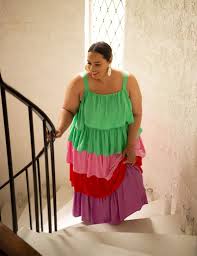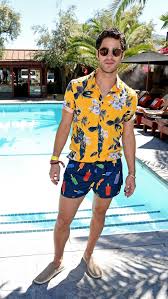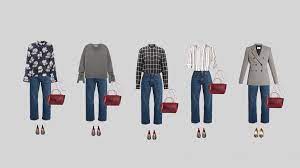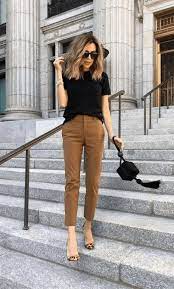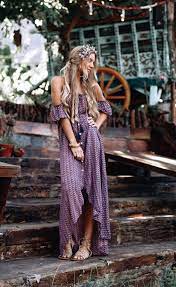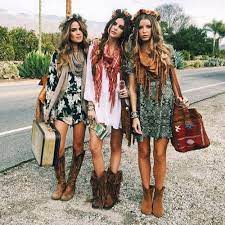Stylish Plus Size Summer Clothes: Embracing Fashion and Comfort
Plus Size Summer Clothes: Embracing Fashion and Comfort
Summer is a time for fun in the sun, relaxation, and embracing your personal style. For plus-size individuals, finding fashionable and comfortable summer clothing can sometimes be a challenge. However, the fashion industry has made great strides in recent years to cater to all body types, including those who wear plus sizes.
When it comes to plus size summer clothes, there are endless options to choose from that allow you to stay cool while looking stylish. From breezy dresses and flowy tops to comfortable shorts and chic swimwear, there is something for everyone to feel confident and beautiful during the warmer months.
One key factor to consider when shopping for plus size summer clothes is the choice of fabrics. Opt for lightweight materials such as cotton, linen, or breathable blends that will keep you cool and comfortable in the heat. Avoid heavy fabrics that may cling or cause discomfort.
Another important aspect of plus size summer fashion is finding pieces that fit well and flatter your figure. Choose styles that accentuate your best features and provide ample room for movement. Don’t be afraid to experiment with bold prints, vibrant colours, or trendy silhouettes that make you feel fabulous.
Accessorising plays a crucial role in completing your summer look. Add statement jewellery, stylish sunglasses, a wide-brimmed hat, or a colourful scarf to elevate your outfit and showcase your personal style. Remember that confidence is the best accessory you can wear!
Whether you’re heading to the beach, enjoying a picnic in the park, or attending a summer soirée, there are plenty of options for plus size individuals to dress fashionably and comfortably. Embrace your curves, celebrate your unique style, and show the world that beauty comes in all shapes and sizes.
With the right attitude and a wardrobe filled with fabulous plus size summer clothes, you can conquer the season with confidence and flair!
9 Essential Tips for Stylish and Comfortable Plus-Size Summer Dressing
- Opt for lightweight and breathable fabrics like cotton or linen to stay cool in the summer heat.
- Choose flowy and loose-fitting styles that provide comfort and allow for better air circulation.
- Look for dresses with empire waistlines or A-line silhouettes to flatter your figure.
- Experiment with bold colours and fun patterns to express your personal style.
- Consider layering with lightweight cardigans or kimono jackets for added versatility.
- Accessorize with statement jewellery, scarves, or hats to enhance your outfit.
- Invest in a good quality supportive bra that fits well to ensure proper comfort and silhouette.
- Don’t be afraid to try different styles and silhouettes to find what works best for you.
- Above all, wear what makes you feel confident and comfortable in your own skin.
Opt for lightweight and breathable fabrics like cotton or linen to stay cool in the summer heat.
When it comes to selecting plus size summer clothes, opting for lightweight and breathable fabrics such as cotton or linen is key to staying cool and comfortable in the sweltering summer heat. These natural materials allow for better air circulation, helping you stay fresh and at ease throughout the day. By choosing garments made from these fabrics, you can enjoy both style and comfort without compromising on breathability during the warm weather months.
Choose flowy and loose-fitting styles that provide comfort and allow for better air circulation.
When selecting plus size summer clothes, opt for flowy and loose-fitting styles that not only offer comfort but also promote better air circulation. These breathable designs help you stay cool and relaxed in the heat, allowing for a more enjoyable and refreshing experience during the warmer months. By choosing garments that provide ample room to move and breathe, you can feel confident and at ease while embracing your personal style in the summer sun.
Look for dresses with empire waistlines or A-line silhouettes to flatter your figure.
When shopping for plus size summer clothes, consider opting for dresses with empire waistlines or A-line silhouettes to enhance and flatter your figure. These styles are designed to accentuate the narrowest part of your body, creating a flattering shape while providing comfort and ease of movement. Empire waistlines draw attention to the bust area and flow away from the body, while A-line silhouettes gently skim over curves, making them versatile and flattering choices for various summer occasions. Choose dresses that make you feel confident and beautiful, embracing your curves with style and grace.
Experiment with bold colours and fun patterns to express your personal style.
Experimenting with bold colours and fun patterns is a fantastic tip for plus size individuals looking to embrace their personal style during the summer months. By incorporating vibrant hues and eye-catching prints into your wardrobe, you can add a playful and dynamic touch to your outfits. Whether it’s a striking floral dress, a colourful geometric top, or patterned bottoms, don’t be afraid to step out of your comfort zone and make a statement. Expressing yourself through fashion is all about celebrating your individuality, so have fun mixing and matching different colours and patterns to create looks that reflect your unique personality and flair.
Consider layering with lightweight cardigans or kimono jackets for added versatility.
When selecting plus size summer clothes, it’s beneficial to think about layering options such as lightweight cardigans or kimono jackets to enhance versatility. These pieces not only provide extra coverage when needed but also add a stylish touch to your outfits. Layering allows you to adapt your look effortlessly from day to night or from casual to more formal occasions, ensuring that you stay comfortable and chic in any setting during the warmer months.
Accessorize with statement jewellery, scarves, or hats to enhance your outfit.
Accessorizing with statement jewellery, scarves, or hats is a fantastic way to elevate your plus size summer outfit and add a touch of personality and flair. These accessories not only complement your clothing but also serve as a reflection of your unique style and individuality. Whether you opt for bold earrings, a colourful scarf, or a chic hat, accessorizing allows you to showcase your creativity and enhance your overall look effortlessly. So go ahead and experiment with different accessories to make a statement and feel fabulous all summer long!
Invest in a good quality supportive bra that fits well to ensure proper comfort and silhouette.
Investing in a good quality supportive bra that fits well is essential when it comes to plus size summer clothes. A properly fitting bra not only provides the necessary support but also ensures comfort and enhances your silhouette. The right bra can make a significant difference in how your clothing fits and how you feel throughout the day. By prioritising a well-fitted and supportive bra, you can enjoy the summer season with confidence and ease, knowing that you have the foundation for a stylish and comfortable look.
Don’t be afraid to try different styles and silhouettes to find what works best for you.
When it comes to plus size summer clothes, a valuable tip is not to be afraid to experiment with different styles and silhouettes to discover what suits you best. Embrace the opportunity to explore a variety of cuts, patterns, and designs that accentuate your curves and make you feel confident and stylish. By trying out new looks, you may uncover hidden gems that enhance your figure and showcase your unique personality. Remember, fashion is about self-expression and empowerment, so don’t hesitate to step out of your comfort zone and embrace the beauty of diversity in styles tailored for every body shape.
Above all, wear what makes you feel confident and comfortable in your own skin.
When it comes to choosing plus size summer clothes, the most important tip to remember is to wear what makes you feel confident and comfortable in your own skin. Embracing your unique style and celebrating your body is key to feeling good and looking great. Whether you prefer flowy dresses, stylish tops, or trendy swimwear, the ultimate goal is to feel empowered and beautiful in whatever you choose to wear. Confidence shines brightest when you are comfortable and true to yourself, so trust your instincts and rock your summer wardrobe with pride.
